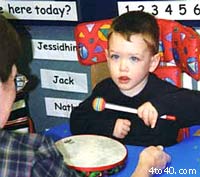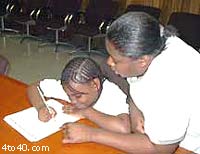 Places conducive to relaxation offer better changes for caring relationships to develop, especially if children feel threatened.
Places conducive to relaxation offer better changes for caring relationships to develop, especially if children feel threatened.
When you are about to tell a child something difficult, don’t do it in the middle of the playground, the middle of the street, the middle of a classroom, or the middle of a family. If it’s something that’s personal and perhaps difficult, find a place that feels peaceful and protective, as conductive to an atmosphere of nonthreatening support as possible.
At home, I usually chose the child’s room for personal sharing. It’s preferable because it is a place that’s mostly their turf and feels safe to them.
In school, I take pains to find a quite place, perhaps the principal’s office or the nurse’s room (as long as it’s unoccupied at the time), so a child can deal with the ensuing fear, hurt, grief, or other feelings without the risk of feeling embarrassed about showing emotions.
For example, I went to the therapeutic nursery to get Hilda, aged four, for her first therapy session. Relatively new in the school, she had been so frightened and withdrawn no one really new if she could talk, or if she was capable of interacting with children, or with anyone for that matter.
It seemed to me that a trip to my office would be a very long one for Hilda, so instead I chose to use the large playroom directly across the hall from her classroom. I had no idea what I would do with this tiny, frightened girl; when anyone let go of her hand, she would not move, she had just stand there as if she were frozen. I chose the playroom as the most relaxed and least threatening place I could think of and hoped it offered a good setting for a trusting relationship to develop between us.
Beginnings are often difficult for children. So are endings. Separations and leave-takings are powerfully emotional times.
 I discovered Chuck’s family was soon to move out of the area, so I wouldn’t be able to work with him anymore. I chose to do something special and peaceful for our last session. Ours had been a tutoring-therapy relationship, and Chuck had worked hard at every session. For this final time together, I gathered some colored pens and sketch pads and said, “let’s go across the street to the park. We’ll just draw and talk.”
I discovered Chuck’s family was soon to move out of the area, so I wouldn’t be able to work with him anymore. I chose to do something special and peaceful for our last session. Ours had been a tutoring-therapy relationship, and Chuck had worked hard at every session. For this final time together, I gathered some colored pens and sketch pads and said, “let’s go across the street to the park. We’ll just draw and talk.”
We never got around to drawing. We just lay on our backs, looking at cloud formations and talking about the different kinds of leave-taking we done in our lives and the people we missed. We talked about the fact that we would not see each other anymore. The park and the billowy sky proved to be a gentle, safe, relaxed, nonthreatening place for encountering a difficult experience.
Chuck had had a fear of separations, but his self-esteem grew as he realized he could deal with a separation without having to deny his feelings of sadness and loss. In fact, not only was I willing to listen to his feelings, but I was also willing to share my own, which confirmed that he was valuable to me. Not only would I miss him, I also trusted him enough to tell him about it. He was important enough that I could tell him. His self-esteem as a valuable person was affirmed.
Self-Esteem Principle: At moment when self-esteem seems threatened, children feel more confident when the sitting is conducive to feeling cared for and valued.
 Kids Portal For Parents India Kids Network
Kids Portal For Parents India Kids Network






